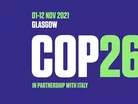Bain briefing: Sustainability strategy for CEOs beyond COP26

A briefing from leading consultants Bain & Company has identified what senior executives globally can expect from the 26th Conference of the Parties (COP26) United Nations conference on climate change, taking place in Glasgow, Scotland, from October 31 to November 12.
Bain says CEOs can expect more regulations, greater demands for climate transparency, and increased scrutiny from both investors and customers.
COP26 comes six years after the Paris Agreement and although many nations have made pledges and commitments, more needs to be done, especially when it comes to implementing these Nationally Determined Contributions (NDCs).
How to address climate change with business decisions and actions
The general consensus seems to point to a required acceleration of plans to reduce emissions. The key areas highlighted by Bain include:
- Regulations
- Financial disclosure
- Science-based targets
- Scrutiny from investors
- Customer expectations
The Bain report says the focus is shifting from target setting to delivery – as words need to translate into action. Bain outlines four key principles on decisions that can make a real difference:
Make carbon transition a pillar of strategy. Sustainability and carbon transition strategies should be part of the core strategy and both mitigate risks as well as identify opportunities.
Get more bang for your net-zero buck. Companies should push their carbon transitions as they would other business initiatives, improving efficiency and effectiveness while measuring and reducing cost.
Embed carbon transition into the fabric of the business. The three key tactics helping companies through their carbon transitions are: pricing, incentives, and tracking.
Avoid the hourglass effect. Sustainability initiatives have a lower success rate, with just 7% meeting all of their goals, compared with 12% of all transformations. This is partly due to the hourglass effect which leaders can address by simplifying targets and providing the training and education for employees.
Bain concludes that the transition away from carbon and toward net-zero emissions is likely to remain a top priority for executives for decades to come, and long after COP26 is a distant memory.
- Executive shakeup at L’Oreal China amid growing complexitiesLeadership & Strategy
- Hyundai brand value soars on back of sustainability visionSustainability
- IndiGo – the high-flying Indian low-cost airlineSustainability
- UOB: making strides in sustainability across Southeast AsiaSustainability
Featured Articles
Nirvik Singh, Global COO and President International of Grey Group, cultivating culture and utilising AI to enhance rather than replace human creativity
On a mission to accelerate the adoption of sustainable energy solutions, US$30 billion Chinese tech firm Longi is not just selling solar – but using it
Armed with an ambitious billion-dollar strategy, Samsung is on track to achieve net zero carbon emissions company-wide by 2050 – but challenges persist



